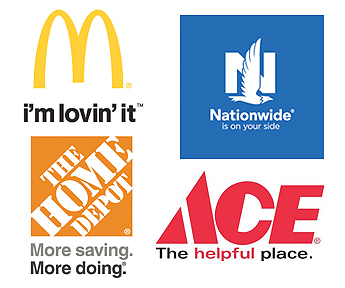 Taglines (a.k.a. slogans) are staples of modern
advertising. These pithy sayings help us identify a brand and are meant to
resonate with a specific target market. But as consumers get more savvy in
their buying habits, you may find your old tagline has something lacking – like
a connection with your customer.
Taglines (a.k.a. slogans) are staples of modern
advertising. These pithy sayings help us identify a brand and are meant to
resonate with a specific target market. But as consumers get more savvy in
their buying habits, you may find your old tagline has something lacking – like
a connection with your customer.
The idea of a tagline is pretty simple. It is meant to
connect you with a brand and to clarify what the brand is all about. Most of
the time we get taglines stuck somewhere in our memory banks and don’t think
much about them. However, there have been some challenges to the validity of
taglines in recent years. This is especially true of brands that are making
claims they cannot back up. Big box stores which have thrived off of moving
large inventories at rock bottom prices have come into the crosshairs. For
instance, Home Depot’s tagline for years was "Lowest Prices Guaranteed.” About
a decade ago that tagline was challenged as being false advertising. Home Depot
modified the tagline to "Low Prices Guaranteed.” Changing "Lowest” to "Low” was
enough to satisfy any legal challenge. It also meant that customers really
wouldn’t notice. But as competition has heated up in the world of discount warehouse
stores, so has the sophistication of price checking among consumers. It is
pretty easy to compare competitive prices with a mobile phone and an app these
days. So Home Depot has changed its tagline to "More savings. More doing.”
Walmart also changed its slogan away from "Always Low Prices” to "Save money.
Live better.” Why did they move away from the specific claims of low price
"guarantees” and the word "always” to the more innocuous word "save”? Because
their market demanded they be honest about their pricing. If they didn’t
change, the market would turn on them, particularly on social media.
As I mentioned above, when taglines are working well, they
get stuck in the far recesses of our brains. We hear a slogan and we know
instantly what brand it represents. It is that familiar to us. When you create
a tagline, there are a couple of rules you should follow. First, it needs to
support what you are trying to accomplish with your marketing. That should
always focus on some distinguishing fact that separates you from the
competition and strikes accord with your customers. Home Depot and Walmart are
discount retailers. They market their low prices. A competitor of theirs for
the home improvement market is Ace Hardware. Ace has a different marketing
tactic. They are the antithesis of big box shopping. They market their customer
service as "the helpful place” and you will know that when you walk into one of
their stores. Their employees greet you at the door and ask what you are
searching for, seek it out for you, offer advice, and will walk you to the cash
register. Using the tagline "the helpful place” would never work at Walmart,
because you are left to find things on your own. The tagline has to fit your
overall marketing strategy.
Second, it has to be memorable. Your tagline needs to be
short and to the point to accomplish this. Some research has shown that we can
remember seven or less syllables in a line pretty easily, but begin to struggle
when a phrase has eight or more syllables. There are some techniques to make your
tagline stick with your target market. Some tagines use rhythm and rime as a
technique for memory. Some taglines are part of a jingle – a short song that
helps you remember the tagline so you can remember the brand. This has been
used ever since mass media advertising came about. However, these techniques
only work if you gear it to your target market. Think about McDonalds slogan,
"I’m lovin’ it!” sung by pop icon Justin Timberlake, or Nationwide Insurance
with football player Peyton Manning going about his day adding his own words to
the jingle, "Nationwide is on your side.” We cannot think of the words without
hearing the tune. It sticks. But it sticks because those pop icons resonate
with certain demographic groups. If 1940’s comedian and singer Ethel Merman
were used to belt out either of these jingles, do you think the target market
(in McDonalds case – Millennials and in the Nationwide case – Gen X)? No way!
Those groups have never heard of Ethel Merman, even though for nearly four
decades, she was one of the most recognized and trusted faces (and voices) in
America.
Another thing to remember about your tagline is it is
useless if you are getting too vanilla in your phrasing. A tagline such as
"Since 1952” really isn’t saying much about your brand other than you are old. A
tagline should enhance the brand in the minds of your customers. How is yours
doing? Is it time for an upgrade? If so, listen carefully to the needs of your
customers. That simple little pithy saying can get stuck in their brains, so
make sure you are saying what they need to hear to do business with you.